postUsonian Addition
Leopard residence |
schematic plan May 5, 2006
by Matt Taylor
|
click on drawings for enlarged view
downloads: pdf format • Canvas format
|
| I designed an office [future link] for Stan several years ago and we have discussed, for some time, us collaborating on a postUsonian environment for his family. As things turned out, the Leopard’s purchased a 3,000 square foot house, on two acres of land outside the city, close to a small creative community. This will be living and work environment for both Stan and Elsa with each requiring substantial studios. |
| This project is the addition of an 800 square foot guest house and a 400 square foot Studio for Elsa. Stan’s Office is in a third bedroom of the house which will be expanded into what in now the den after the additions are built. This arrangement orients both the Studio and Office close to the driveway and parking allowing direct client access without disturbing domestic tranquility. |
| What follows is a brief walk through the schematic concept. This is supplemented with a Program Statement [future link]. The design as conceived will be built in place, in 2007, in the Bay Area idiom which depends on local crafts and still evolving traditions of long standing [future link]. This approach will best fit with the existing structure and the outdoor living aspect of how the two additions must fit with the to-be-built swimming pool and landscape plans. The postUsonian aspect will be most found in the interiors which will be the first full scale, shop-built expression of the new postUsonian grammar which fits very well with the Bay Area Style [future link]. These interiors will also provide the same flexibility as the MG Taylor-AI work environments [link: 20 years of taylor environments]. This is rarely done in domestic architecture and never, as far as I know, to the degree of this design as a systemic approach. This flexibility will greatly enhance the utility of the two units. |
| All these factors combine to make an intimate environment. To design for friends is much like building for yourself. On the level presented here, this project is in the schematic phase and will remain in Design Development for some time. There are a few specific things that have to be tied down so that pool and landscaping can be done this year. The geometry of these elements in relationship with the two additions is exact. Once this is established - in Work Package One - Site development Plan [future link] - I have a year to prepare the drawings for pricing and construction. I intend to take this time and enjoy the process of evolving the design and putting great thought into the details. It is the detailing and the materials that will make these two environments come alive. They are in the the Arts and Crafts tradition [future link] and represent an aspect of architecture which is, unfortunately, rapidly fading from contemporary work. |
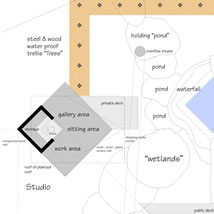 |
Two new structures create an outdoor “family room” commons. The swimming pool deck forms a square with the pool turned on a 45 degree bias. This adds interest and makes the deck more usable and sub-divided.
The Studio and Guest House are positioned in relationship to the deck centerline axis, the pool, and each other’s diagonal axis.
The existing dry creek, which becomes ponds and “wetlands,” separates the family area from the Studio while still allowing parental oversight.
The Studio faces North. The “public” area of the Guest House receives afternoon sun and “private” Sleeping and Work Sace areas the morning sun.
An ENTRY is created from the Parking area to the outdoor commons for family and business intimates.
Green roofed trellises connect the structures and provide sun and rain shelter. |
|
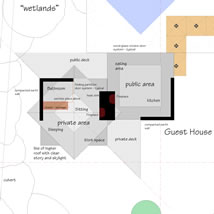 |
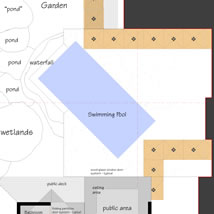 |
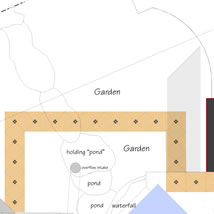 |
| The material palette is basic: tile heated floors - with modest sized, natural fiber rugs; compacted earth walls; colored concrete lintel beam; naturally finished wood douglas fir beams and joists, redwood mullions and trellis members with steel stiffening; planted flat roofs and Studio sloped roof; tile roofing at the Guest House apex. The interior walls, trim, armature and furniture will be the traditional AI mix of clear finished baltic birch plywood, dimensional maple and cherry trim. Exterior decking, naturally finished redwood. Door and window glazing, double paned, slightly tinted glass with colored poly patterns and baltic birch shutters. |
| The landscaping around the immediate area of the commons, Studio and Guest House is a critical component of their functioning. The orientation of glass, view - in and out - and light is designed to specifically augment the function of each space. The real outer dimension of each living and work area is actually the landscaping - this is what defines their space. This as true for the existing house, that is oriented toward the commons, as for the additions. These landscaping requirements will also have to be compatible with the landscaping plan for the entire two acres. The basic concept, at the parameter, is to create a series of permeable plant screens that, additively, create an “infinite” horizon. At the North by Northwest side of the commons, bounded by the Garage and Entry deck and crossed by the Trellis and walk to the Studio, is a Garden area for both ornamental flowers, herbs and food. Between the commons and the Studio, running the entire West-East axis of the property, is a deep cut “wetlands” for drainage, ponds, “natural” landscape and holding areas. This creates a “separation” between the Studio and the house while still allowing necessary access. The “wetlands” also lends a distinction to the higher ground of the rear property by providing it a defined boundary. A main feature of the rear area is the meditation spiral which will be viewable and accessible by wandering paths from the Sleep area of the Guest House (which receives morning light) and the work area of the Studio. From the commons and pools area, the spiral is more distant but perceivable as a diagonal view. |
|
The Studio is for the creation, display and sharing of multimedia. It is Elsa’s personal workspace and retreat. It is composed of a 20 foot by 20 foot square on the bias with its apex aligned to the center line of the square deck formed by the shape of the main house. The landscaped Studio roof is a rectangle, that follows this axis, and slopes from ground level - at the storage mass - upward toward the commons area. From the rear, the roof will appear to be an extension of the landscape. The glass wall of the Studio slopes inward from the East and West sides and outward to the roof edge on the pool side. The base of the glass wall follows the line of the floor. This arrangement makes the glass walls to slope inward on the sides and outward toward the pool. While a rectilinear structure, the entire aspect is that of a triangular building pointing North. While employing the same material and detailing grammar as the Guest House, this configuration creates a higher and more dramatic space appropriate to a workplace of this kind. This massing anchors the South side of the commons and presents a strong presence even with a small footprint. At the top leading edge of the roof, a drop-down screen allows back projection that can be viewed from the pool and deck area providing a home outdoor theatre. Speakers will be placed at the pool area.
The spaces within the Studio serve several functions: Work Area - which will be a computer workstation with multiple screens and related media equipment; Gallery - for both digital and physical display of both finished product and artifacts made in the creative process; a “soft” Sitting Area - for thinking and informal conversations; and Storage. With the exception of storage, which is housed in the compacted earth thermal mass, all areas will be flexible and defined by storable-movable screens which also can serve as display and work surfaces. A large flat screen with speaker system will be mounded on a wood rolling caddy.
A skylight is positioned at the leading edge of the compacted earth mass which rises above the roof line. This will provide controllable South light. The side walls will receive Eastwardly and eastwardly light which will be screened by landscaping and adjustable shades built into the window walls. The main light orientation is toward the North, North East. The Studio will enjoy largely reflected north light with morning and late afternoon highlighting.
The “private” deck cantilevers over the “wetlands” providing closeness yet separation with the commons area. This pattern is repeated at the Guest House only in reverse. |
|
|
t h e x G U E S T xH O U S E |
The Guest House is composed of two 20 foot by 20 foot rectangles. These define the “public” and “private” areas within. The offset between each provides distinction without isolation. The “public” wood deck between the pool deck and the interior “private” area acts as a buffer while allowing access from the commons to the Guest House as, from time to time, will be required. The “public” deck also cantilevers over the “wetlands” offering an unique place of both prospect and refuge. The “private” deck off the Kitchen and Work Space areas provides an outdoor setting which is screened by landscaping and sheltered from direct sun except to the morning light - a great place for morning tea or coffee and a cool afternoon away from busy activities and social interaction.
The compacted earth walls create thermal mass in two “L” sections and at the fireplace core and hearths. With the exception of the Bathroom fixtures and cabinets, as well as, the Kitchen fixtures and cabinets, all partitions and furniture in the Guest House is movable and able to configure so as to create several different room layouts. This is necessary as the actual use of the Guest house is expected to vary over the years.
The Guest House will be a place for friends and business associates to stay for overnight to extended visits. It also may be employed for a living environment of some duration for parents and older children. During time that actual guests are not using the space - and this may be a substantial amount of time - the Guest House becomes a Family Room. The glass walls will fold back creating easy access to Bathroom and Kitchen. This takes a load off the main house and allows a mixed venue of use. Each of these uses have distinctly different space and configuration requirements and these uses may vary from day-to-day. Therefore the reconfiguration process has to be swift and easy.
It should be noted that the ability to have flexible space, while still achieving permanent looking architectural spaces, is an economy as a far greater utility can be accomplished, without having to build a great number of single-purpose rooms, as is the usual approach to achieving functionality. The Guest House is designed to function as a completely independent living space for a couple, as a living and work space for a business associate, and as an extension of the existing house for a couple and two young children. It can also be configured to be as an indoor/outdoor entertainment space for larger gatherings. The Leopards intend that their home environment be family, working and entertainment space - a socially self sufficient home-work stead.
The roof of the public area of the Guest House will be flat, planted and will have little overhang. The roof at the parameter of the private area will be the same; over this, with a clear story, will be an inverted square pyramid tile roof with a skylight in the center. The clearstory window will allow continuous strip of light from all four side even when the window wall glass and doors are shuttered. The Bathroom will have a lower ceiling. The combination of the lower bath ceiling and the open pitch of the pyramid roof creates a “secrete” place - a get-away loft for children and adults. |
|
|
t h e xO U T D O O R x F A M I L I Y xR O O M |
The Outdoor Family Room commons serves many recreational and entertainment functions. The existing house, itelf has generoius sized rooms with facility for privacy for everyone. The living-family and dining areas are more than adequate to facilitate the daily, more formal, interactions of the family. Each of these spaces are organized such that various family members naturally “own” them.
The out door Family Room functions as a commons - not that there will not be rules-of-engagement and use - it is “owned” and used my all including guests be they family, friends or business associates. The arrangement of the space determines this even as it creates sub-areas so that different activities can have integrity when required.
This commons encourage outdoor living which, despite California’s weather, has not been as robustly supported by recent housing as it was, for example, in Southern California in the 30s, 40, and 50s and Northern California in the 20s and 30s. This commons is designed to be a social space as well as a recreational one. |
|
|
t h e x G A R D E N x E N T R Y |
The Garden Entry provides an informal entry-exit to the entire complex. Stan’s work area is directly accessible from the drive and parking area. Elsa’s Studio can also be reached directly without entering the family space. The formal Entry to the house is centered on the North side of the house. It will be used rarely but more often after the landscaping plan is completed. The West deck provides direct access for close friends and associates. This formality-informality equation is modulated by the architecture. There is a natural transition which takes place as one travels through the Garden. Upon arriving at the commons several choices are available - this creates a rich experience. One is not thrown into anything. Areas of relative prospect and refuge are offered no matter the level of activity that may be present.
The trellis provides an architectural transition between the existing structure and the new ones. It provides a sheltered walk to the Studio, the Guest House and the parking area. It makes an overhead, horizontal landscaping plane. It ties all of the various element together into one whole. The “walk” to the Studio is indirect and “travels” through a recreational patio, a garden, a “wild” landscape to the Entry of the Studio itself. A short trip in absolute length yet one that - because of the many transitions - prepares for the task of creative work. While shorter, the path to the Studio from the parking area has the same effect.
This part of the complex creates ENTRY and EXIT - critical elements too often neglected in modern architecture. While important everywhere, the integration between the landscaping plan and the architecture is particularly important in this area. This is the overture and the final credits of the experience. |
|
|
| This outline description covers the basic elements of the design. The Program Statement [future link] will explore the historical and philosophical basis of the design, as well as, describe in greater detail the functional requirements of of each area. Preliminary Design [link: leopard_preliminary plan] will further explicate the architectural grammar of the project and provide floor plan development, sections and elevations. The Structural grammar and basic details will also be established. Schedule and Work Packages [future link] will indicate an outline schedule of work in discrete trade work segments. All of these, together Create the Problem [future link] to be solved, in Design Development and Contract Documents as the design is engineered and built. |
| Several tasks are required, within the first 60 days of the project, to facilitate ongoing landscaping and swimming pool work and to achieve the necessary foundation so that design, engineering a contract documents can be accomplished to prepare for a 2007 construction date. |
A
Meetings with Landscape and Swimming Pool design-contractors.
By May 15th, provide information so that the design of landscaping and the pool design and pricing can immediately proceed.
Create working relationships so that the landscaping, pool designs and building additions are effectively integrated.
B
Site Survery. This work has to be performed immediately as detailed work cannot proceed until accurate information is in hand.
The following is required:
Accurate dimensions of the existing building, including verification of the square-ness of the outer walls on the South side of the house.
Location of the property lines in relationship to the existing building, major trees, pump house and water storage tanks and any other built elements or major site features that may impact the project as designed.
Grades, at the rear property, providing accurate contour lines in one foot increments.
Soil tests in the immediate area of the new structures so as to insure that adequate bearing can be designed.
Stake out of the new structures based on the present design.
Evaluation of the worst case water flow through the existing “dry creek.” |
This information will form the basis for the Taylor Architecture Site Plan - see “C” - which will allow landscaping work and pool construction to proceed while remaining congruent with the final build-out of the additions. It is expected that a retaining wall will be necessary at the South corner of the Swimming Pool. Details and engineering for this will be provided as part of the Taylor Site Plan.
C
The Site Plan will locate the Studio and Guest House additions exactly, provide a cut and fill diagram for the “wetlands” area, provide necessary engineering for any required swimming pool retaining wall, and necessary soil stabilization and compaction work. This work will be completed within 30 days of the Site Survey - see “B” - being provided.
D
With in 90 days of the survery being completed, Design Development will have proceeded sufficiently to provide a resonablly accurate Model of the project cost, work packages, contracts structure and construction-fabracation schedule.
Successful completion of A, B, and C will allow 2006 work to be completed and will identify the work necessary to be done, at this time, in order to prepare for the additions, and establish a basis for completing the Design Development drawings, preparing the permit set, work packages and contract documents necessary for the 2007 work. D will establish a project cost and schedule budget. |
|
|
t h e x T a y l o r x A r c h i t e c t u r e x T e a m |
Fred Stitt: Architect of Record; project audit and oversight.
Matthias Oppliger: Project Architect; Design Development collaborator with Matt Taylor, Contract Documents, permits and work packages, construction supervision (with Matt Taylor).
Jerry Headly: Architect, VP and principal with Taylor Architecture; support for the West Coast team members.
Bill Blackburn: Designer of AI interior systems.
Bryan Ross: Master Craftsman, development of AI interior components and interface with AI shop production and installation crew.
Patsy Kahoe: Communication and logistics management; Team coordination.
RK Bruce: Financial Management for MG Taylor, Taylor Architecture and ValueWeb associates for this project.
Matt Taylor: Project concept, program and preliminary design, system integrator, primarily responsible for relationship with the Leopard family.
Stan Leopard:
Client and owner - yes, in the legal sense; active design collaborator and project steward necessary to achieve the excellence desired by all.
On a personal note, it took me 50 years to bring a team with this level of experience, talent and creativity together. This may seem to many a “small” and “modest” project - it is much more significant than size, budget and how society now measures importance indicates. It is an unique gathering of people and an opportunity to do it right. |
| The Taylor Architecture Process is iterative and collaborative. The design as represented - at this moment in time - is a literal translation of the requirements expressed by Stan. The difference, between a good piece of work and a work-of-art [future link] that meets the present and future requirements of the Leopard Family and office, is achieved by what happens between now and the completion of the project, as well as the ability of the “completed” work to evolve and adapt over time. It is important to recognize that the design process itself modifies the thinking of all those involved. It is natural that the concept of the environment and its use change as the project moves through design, engineering, building and first use. |
| This means that the design will evolve while the goals and principles expressed in this document will remain intact and never compromised. Everyone’s full participation, including builders, is required; everyone’s integrity has to be respected as must be the integrity of the environment which we seek to create and whose purpose we serve as much as our own. |
| There are three primary interrelated objectives of this project: To create, with Stan, the environment desired at the least possible cost (money, time, disruption) and to do this by always “trading up” to better solutions not “down,” by compromise, to inferior results. To advance the state-of-the-art of the post Usonian ideal [link: the usonian house]. And, to do all this as a consequence of GroupGenius making the entire process enjoyable, inspiring, growth inducing and legitimately profitable to all those who engage in this work. |
| Great Architecture cannot be achieved by poor and ugly means. Architecture is built philosophy [link: authentic architecture thesis] - the merging of spirit and physical - it cannot be faked. It is the measure of what we are and what we want to become. The act of desire, the act of design, the act of making - and the relationships we forge by doing so; and, how the resulting environment is used and kept - IS Architecture - not the mere building as a dead object. Anything less is a failure to live completely, a waste of resources, an act of misplaced egotism and a denial of true self. |
| Let us build a Cathedral for the lives to be lived within this environment and by this act let us become Cathedral builders [link: cathedral building]. Making a private residence - the place for a family and for each individual within it - is, to me, the most sacred act of architecture that can be rendered. It is to approach life on a primary level. The making of habitat is a core requirement of every species. A look at what the Human Race is doing to itself and the planet [link: a future by...]is a measure of how far we have drifted from being connected to ourselves, each other and Gaia [link: gaia project]. |
|
project update - August 5, 2006 |
Since my last posting, on the 11th of June, Matthias Oppliger and I have completed the Preliminary Phase of the work. In the interim, there has been a significant changes in some aspects of the projects program and these are reflected in the the design as it has evolved. In addition to programmatic changes, the design has evolved in many subtle ways.
While there are many refinements ahead, which will be discovered in the Design Development process, the concept is now a build-able project.
For drawings and narrative, click on the Plot Plan below which will take you to the Preliminary Design Documents: |
Design Development work will proceed on a schedule to be determined by the building schedule. Because of the evolution of Stan’s thinking and change in circumstances, there are three scenarios which will determine this date: a) Stan my decide to keep the house and build out the project as designed; b) He may decide to build the project with the view in mind to ultimately sell the property so that we can design an entirely new complex from the beginning at some future date; c) He may sell the property as is, with the plans as an example of its potential for the new owners to consider, and build new as soon as this is possible. This is primarily an economic decision based on land costs and the sale value of the Existing house. At present “c” is the most likely outcome.
In scenarios “a” and “b,” Stan will move into the Studio/Office as his office in the Houses 4th Bedroom is now occupied by his daughter attending a local collage. This change required a redesign of the Studio.
For now, I am designing his office to live in the dining room space [link: leopard home office] and, over the next year, all these options will be explored including looking for a new suitable lot. The day-to-day experience of living in the house, as is with a few modifications, will inform the decision and ultimately what is built along with the economic consequences.
The main lesion from the exercise is that it is likely possible to build a new environment, that does what the existing house and additions do together, in less square footage and for a reduced total cost allowing the return of significant capital to Stan’s business and a reduction in monthly overhead that does not, in fact, provide superior amenity.
All this said, this house and additions may well be an ideal solution for a couple with a large or extended family, home office and entertainment requirements on the scale the existing House, Guest House and Studio/Office will provide.
From the point of view of how the two additions fit onto the site and integrate with existing house, this design works very well. The additions complete the back yard, extend the existing structure out into it, and create a viable outdoor living area.
This Program - which no longer totally fits Stan’s requirements - will be developed in the Program Statement [future link] which formed the foundation for the completion of the Preliminary Design phase of work [link: leopard preliminary plan]. |
|
|
| GoTo: Preliminary Plan and Notes |
|
|
|
|
| GoTo: Preliminary Plan and Notes |
|
|
|
|
| GoTo: Tour MGT Environments |
|
|
|
|
| GoTo: Bay Area Studio for Matt Taylor |
|
|
|
Matt
Taylor
Elsewhere
May 4, 2006
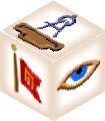
SolutionBox
voice of this document:
VISION • STRATEGY • SCHEMATIC
|
|
|
posted:
May 4, 2006
revised:
August 8, 2006
• 20060504.411129.mt • 20060506.882010.mt •
• 20060507.444400.mt • 20060511.768301.mt •
• 20060805.651209.mt • 20060808.309010.mt •
Copyright© 2006 Matt Taylor
(note:
this document is about 96% finished)
|
|
|